Oxford and AstraZeneca vaccine: Where is it made and how effective is it?
Want to know more about the Oxford vaccine? This is what we know so far about when it will be approved and rolled out across the UK.


The Oxford/AstraZeneca vaccine was created by the University of Oxford and distributed for the first time on Monday January 4 2021 in the UK.
After it was approved, the Oxford vaccine joined the Pfizer vaccine in creating the country's Covid-19 vaccination programme. Since late December 2020, over 23 million people have now received their first dose of either vaccine and the top nine priority groups are on target to be vaccinated by the end of April.
However, research on the Oxford and AstraZeneca vaccine is ongoing to determine essential factors, such as whether pregnant women can have the vaccine and what life will look like after vaccinations are available. Scientists from around the world are also continuously looking to side effects of the vaccine and, most recently, they have suggested there is a possible link between the Oxford vaccine and an increased risk of blood clots. It has led some countries to suspend their use of the vaccine already, pending review from the World Health Organisation.
This is what we know about the Oxford vaccine, who created it and what the side effects of the vaccine could be.
Where is the AstraZeneca vaccine made?
The "vast, vast majority" of the doses will be made in the UK, according to Ian McCubbin, the manufacturing lead for the UK's Vaccine Taskforce. However, he also revealed that the initial doses of the vaccine will actually be produced in the Netherlands and Germany as “a little bit of a quirk of the programme”.
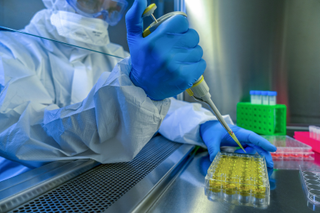
“But once that’s supplied, which we expect will be all by the end of this year, then the remainder of the supply will be a UK supply chain.”
This doesn't currently take into account the possible border delays that could occur from January 1 as a result of Brexit. It's already been confirmed that there will be challenges initially on products entering the country, most of them coming from greater custom controls and more restrictions on hauliers between Kent and Dover.
GoodtoKnow Newsletter
Parenting advice, hot topics, best buys and family finance tips delivered straight to your inbox.
However, high priority has been given to both the Oxford and Pfizer vaccines by the government and the international firms behind them. This means it should be easier to move the vaccines into the country through new routes, avoiding delays, than some other products.
What are the side effects of the Oxford vaccine?
Side effects of the Oxford/AstraZeneca vaccine tend to be mild to moderate and could include the following:
- Tenderness, pain, warmth, itching or bruising where the injection is given
- Generally feeling unwell
- Feeling tired and minor fatigue
- Chills or feeling feverish
- Headache
- Feeling sick
- Joint pain or muscle ache
- Swelling, redness or a lump at the injection site
- Fever
- Being sick or diarrhoea
- Flu-like symptoms, such as high temperature, sore throat, runny nose, cough and chills
These are often gone within a few days of vaccination, with some cases still presenting side effects after one week. The NHS recommends using paracetamol to ease any uncomfortable symptoms.
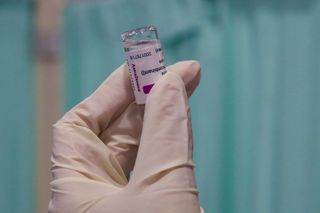
Some more severe side effects have been reported, which include:
- Feeling dizzy
- Decreased appetite
- Abdominal pain
- Enlarged lymph nodes
- Excessive sweating, itchy skin or rashes
In some clinical trials, there were some very rare reports of incidents relating to the inflammation of the nervous system. This may cause numbness, pins and needles and/or a loss of feeling. These side effects, however, have not been explicitly related to the vaccine.
Severe allergic reaction was also one of the more severe side effects reported, but is considered to be extremely rare and related to underlying health conditions, such as asthma. Due to this side effect, after having the vaccination, people are required to wait at the vaccination site where medical care is available for around 15 minutes.
Why are countries stopping the Oxford AstraZeneca vaccine?
Some countries have suspended their use of the Oxford/AstraZeneca vaccine over concerns that it could be linked to an increased risk of blood clots.
Countries including France, Germany, Spain, Norway, the Netherlands, Portugal, Slovenia, Sweden and the Republic of Ireland have stopped administering the AstraZeneca vaccine following reports of blood clots in the days and weeks after the vaccination was first administered.
Following this, a review from Norway's medicines agency revealed that there had been four new cases of "serious blood clotting in adults". The European Medicines Agency (EMA) have also confirmed that one person in Austria was admitted to hospital with pulmonary embolism, which is a blockage in the lung arteries, and later died. Another death where blood clotting was involved after vaccination was reported in Denmark.
The EMA has said that there is "currently no indication that the vaccination caused these conditions" and urged people to still have the vaccine, as the benefits greatly outweighed the risk.
They said, "Events involving blood clots, some with unusual features such as low numbers of platelets, have occurred in a very small number of people who received the vaccine.
"Many thousands of people develop blood clots annually in the EU for different reasons. The number of thromboembolic events overall in vaccinated people seems not to be higher than that seen in the general population."
The Medicines and Healthcare products Regulatory Agency (MHRA) in the UK has also said, 'We are closely reviewing reports but the evidence available does not suggest that the blood clots were caused by COVID-19 Vaccine AstraZeneca. People should still go and get their COVID-19 vaccine when asked to do so.'
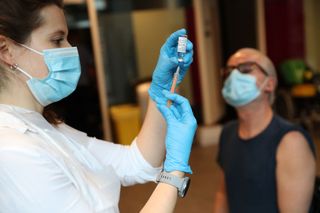
How many blood clots have been potentially linked to the Astrazeneca jab?
A review is currently being undertaken into each reported incident of blood clotting that potentially relates to the Oxford vaccine - which is 30 blood clots currently.
This number is out of the five million people who have been given the Oxford vaccine across Europe.
Why do some people react to the Covid vaccines?
People react differently to the Covid-19 vaccines, whether the Oxford or Pfizer vaccine, for different reasons. Similarly to why Covid-19 affects people differently, factors including sex, age, previous Covid infection and the vaccine itself play a role in whether one person will have worse side effects than another.
Sex
Multiple studies have proven that women are able to fight infections better than men in general, as they have stronger immune system responses to foreign antigens (like viruses). However, they are also proven to experience more adverse side effects. The most recent study from the US Center for Disease Control on this relates specifically to Covid-19, where it was reported that 79 percent of the adverse side effects were had by women.
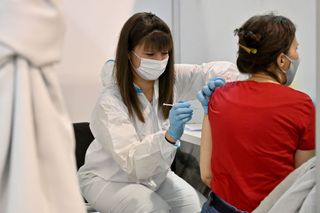
As well as naturally having stronger responses to infection, there are also genetic and hormone factors in play. X chromosomes for example, of which women have two and men have one, contain many genes that regulate immune and cellular function.
Previous Covid-19 infection
Equally, those who have had the Covid-19 virus appear to show more symptoms after the first dose than those who haven't been infected with the virus before.
Results from the ZOE Covid symptom study, which is led by Professor Tim Spector at Kings College London and is the world's largest ongoing study of Covid-19, concluded that those who have had Covid-19 before are twice as likely to suffer side effects from the vaccine. These side effects are likely to be numerous and affect the whole body, with the most common ones being fatigue, headache, chills and shivers. These lasted for the first two days after vaccination and only three percent of people went onto experience longer-lasting side effects.
Antibody response
One reason someone might experience worse symptoms with the Oxford jab is that it offers a more "rounded" antibody response. Dr Claire Steves told The Telegraph, “There is evidence that the AstraZeneca jab may produce a more ‘rounded’ antibody response, and more of a response from our T-cells, which are another part of the body’s natural immune response.
“This can mean you get symptoms such as fever, tiredness and aches as your body adjusts. But, reassuringly, our data shows that 98.3 per cent of people feel better within a week.”

Second dose proven to cause more side effects
Experts suggest that people are more likely to have stronger side effects after a second dose of the Pfizer Covid-19 vaccine than the first dose. The same data isn't available for the Oxford vaccine as this study was completed in the US, where the Pfizer and Moderna vaccines are being distributed.
According to research submitted to the FDA, seven percent of people between the ages of 18 and 55 who received the first dose of the Pfizer vaccine reported a fever. This was significantly lower than the 31 percent of people who reported a fever after the second dose of the vaccine. While the Moderna vaccine, which has now been approved for use in UK but not yet distributed, has a one percent rate of people aged 18 to 64 reporting fever after the first dose. This compared to the 17 percent who reported a fever after their second dose of the Modern vaccine.
Who funded the Oxford AstraZeneca vaccine?
The UK and US governments have funded the Oxford AstraZeneca vaccine, under the promise that the company will deliver millions of vaccines worldwide.
Oxford University revealed that they had received £65.5 million in government funding in May last year for the Covid-19 vaccines, following early trial success. Also in May last year, CNBC reported that the U.S. Biomedical Advanced Research and Development Authority had given AstraZeneca more than $1 billion in funding for the coronavirus vaccine.
AstraZeneca itself has also invested in the vaccine, but doesn't stand to make any profit from it until the pandemic is over. The pharmaceutical company predicts, according to Sky News, that it will spend $6 billion (£4.5 billion) on the production of three billion doses of the vaccine by the end of 2021.
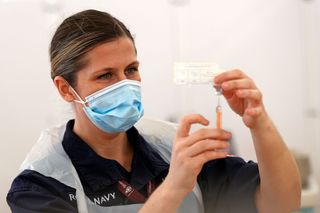
Is AstraZeneca a UK company and where are the factories?
AstraZeneca is a joint British and Swedish company and their headquarters are located in Cambridge, England.
It was formed in 1999 through the merging of two different companies: Swedish organisation Astra AB and British company Zeneca Group. Although they mainly operate out of the UK, with one of their research and development centres also in Cambridge, they also work from Gothenburg in Sweden and Gaithersbury in Maryland, USA.
Is the AstraZeneca vaccine effective?
A recent study has found that a single dose of the Oxford vaccine offered 76% protection for three months. Followed by the second dose, this increases the vaccine to 82% effective.
While it's not as high as the 95% effectiveness of the Pfizer vaccine, it's considerable enough to be successful. The flu vaccine, for example, is only 50% effective in most cases.

The same study also produced some hugely positive news. As well as protecting the individual with the vaccine from contracting Covid-19, the results showed that the Oxford vaccine could reduce transmission of the virus by 67%.
Is the AstraZeneca vaccine effective for over 65s?
The AstraZeneca and Oxford University vaccine is effective for over 65s, despite what recent reports from Germany suggest.
Germany's disease control agency, the Robert Kock Institute, said in late January that the Oxford vaccine should only be given to those aged between 18 to 64. They put this down to a lack of data from those aged over 65 years old, suggesting there were doubts on how effective the vaccine was for people in this age group. In all other aspects, they concluded that the Oxford vaccine was just as suitable as the Pfizer and Moderna vaccines.
Multiple experts have dismissed this idea, however, including Astrazeneca themselves. A statement from the company, before the vaccine was later approved for use elsewhere in Europe, reads, “Reports that the AstraZeneca/Oxford vaccine efficacy is low in adults over 65 years are not an accurate reflection of the totality of the data. The latest analyses support efficacy in this age group, which we expect to be published by the EMA in the coming days.”

While Dr June Raine, chief executive of the UK Medicines and Healthcare products Regulatory Agency (MHRA), said, “Current evidence does not suggest any lack of protection against Covid-19 in people aged 65 or over. The data we have shows that the vaccine produces a strong immune response in the over-65s.”
Head of immunisations at Public Health England, Mary Ramsay, also backed the call for approval of the Astrazeneca vaccine and explained the reasons for the doubt. She said there "were too few cases in older people in the AstraZeneca trials to observe precise levels of protection in this group" but the data they did have on immune responses was "very reassuring".
Will the vaccine work against the new Covid-19 variants?
The vaccine works against the UK variant of Covid-19, first discovered in Kent, and the South Africa variant to some extent. This is why, after 100 cases of the South African variant were discovered in England, parts of the UK are now undergoing mass testing programmes.
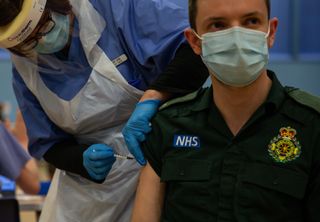
Epidemiologist Dr Susan Hopkins told Sky News that three of the vaccines (including the Oxford vaccine) were effective "at a level greater than what was set as a minimum standard set by the WHO".
"We expect all other vaccines to have a similar level of effectiveness, particularly in reducing hospitalisation and death."
"What we do know is that [the variant] has more mutations… that is causing perhaps to have diminished effectiveness to a vaccine but still very good."
However, scientists from the University of Oxford are preparing to make changes to the vaccine to beat any emerging Covid-19 variants. It's thought that the team behind the Oxford and Astrazeneva jab will take on studies to reconfigure the vaccine at just 48 hours notice, to get it ready to distribute.
When will the Oxford vaccine be ready to distribute?
Now the Oxford vaccine has been approved, it's ready to distribute. From Monday December 4, the government began vaccinations with the Oxford and AstraZeneca jab to all those high on the priority list. Brian Pinker, 82, was the first person to receive the vaccine as part of the efforts to curb the virus around the country.
It's a spot of good news among the announcement of further tier 4 restrictions on millions of people around the country, after a new variant of the virus was discovered in the UK in December. On December December 29, 53,135 people tested positive for Covid-19, which quickly became the highest single day rise since mass testing began. There were also 414 more deaths within 28 days of a positive test.
Speaking on the distribution of the Oxford University and AstraZeneca vaccine, Health Secretary Matt Hancock said, "This is a pivotal moment in our fight against this awful virus and I hope it provides renewed hope to everybody that the end of this pandemic is in sight."
But he added to "keep cases down and protect our loved ones", it's essential to follow social distancing rules and coronavirus-prevention measures such as increased hygiene.
Is the Oxford vaccine a live vaccine?
Technically the Oxford vaccine is live, but it's not as scary as it sounds. The Oxford vaccine is created using a common cold virus (not the Covid-19 virus) from chimpanzees and removing about 20% of the virus’ instructions.
This means, according to the university, that the vaccine cannot cause disease in humans but it can be made in a laboratory under special conditions.
The 20% space is then replaced with the instructions for the spike protein from Covid-19. Once inside the human cell, the instructions have to be replicated over and over again in a process known as transcription. It’s this repeat replication that is used to make large amounts of the spike protein.
This is essential for the vaccine to work as when the spike protein is made, the immune system reacts to it and pre-trains our systems to identify and destroy a real Covid-19 infection in the future.
This is one of the things that makes it different to both the Pfizer and Moderna vaccines, professor of vaccinology at the University of Oxford, Sarah Gilbert explains, as these are both mRNA vaccines and “no virus is needed to create the mRNA vaccine”.
“This means the rate at which the vaccine can be produced in accelerated.” She explains, but emphasises that the Oxford vaccine “uses a harmless, weakened version of a common virus which causes a cold in chimpanzees.”
“Researchers have already used this technology to produce vaccines against a number of pathogens including flu, Zika and Middle East respiratory syndrome (Mers). The virus is genetically modified so it is impossible for it to grow in humans.”
Who will get the Oxford vaccine first in the UK?
The Oxford vaccine was rolled out to those most vulnerable to the virus first. Then the rest of the population, just like the Pfizer and other vaccines.

With well over 20 million people now vaccinated with either the Pfizer or Oxford vaccine in the UK, the top nine priority groups will have been offered their first dose of the vaccine by April 15. By February 15, the top four priority groups had been vaccinated.
How many Oxford Covid vaccines does the UK have?
The UK government has ordered 100 million doses of the Oxford vaccine, which is enough to vaccine 50 million people.

These doses will be enough to vaccinate the entire population (apart from children), the health secretary has said. Especially as they'll be combined with the full amount of Pfizer and BioNTech jabs ordered.
Children, alongside pregnant women, are one of the demographics currently not being vaccinated as part of the government's programme.

Grace Walsh is a health and wellbeing writer, working across the subjects of family, relationships, and LGBT topics, as well as sleep and mental health. A digital journalist with over six years experience as a writer and editor for UK publications, Grace is currently Health Editor for womanandhome.com and has also worked with Cosmopolitan, Red, The i Paper, GoodtoKnow, and more. After graduating from the University of Warwick, she started her career writing about the complexities of sex and relationships, before combining personal hobbies with professional and writing about fitness.
-
 Compromising may be killing your relationship - here are 5 ways to reach healthy compromises, according to relationship expert
Compromising may be killing your relationship - here are 5 ways to reach healthy compromises, according to relationship expertCompromising isn't always the best way to keep the peace in a relationship
By Charlie Elizabeth Culverhouse Published
-
 Best interactive pets for kids: 15 gift ideas for children of all ages
Best interactive pets for kids: 15 gift ideas for children of all agesFrom puppies to axolotls, take a look at our selection of the best interactive pets you can buy that are sure to be a hit with little animal lovers
By Sarah Handley Published